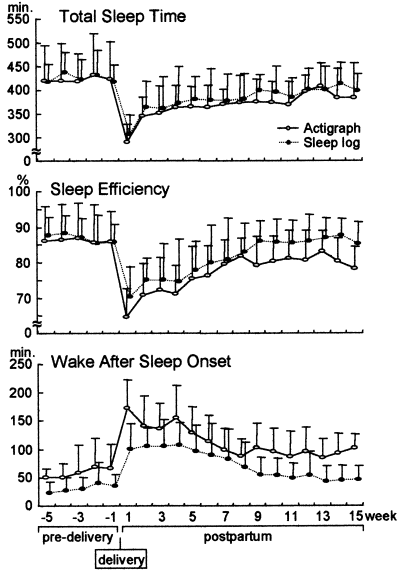Longitudinal study for sleep–wake behaviours of mothers from pre-partum to post-partum using actigraph and sleep logs
Abstract
Abstract To understand the sleep–wake behaviours from the fifth pre-partum week to the 15th post-partum week by the number of actigraphic activities and sleep logs were evaluated in 10 women. It was found that total sleep time shortened, sleep efficiency decreased, and wake after sleep onset (WASO) increased in the weeks immediately after delivery. Compared with late pregnancy, total sleep time and sleep efficiency deteriorated significantly from the delivery week to the 12th post-partum week and there was a longer period of WASO until the 11th postpartum week. The after-delivery sleep parameters estimated by the actigraph were worse than those estimated from sleep logs.
INTRODUCTION
There have been few longitudinal studies on the sleep–wake behaviors of mothers from pre-partum to post-partum using wrist actigraphs, which enable us to observe sleep–wake patterns. We examined the number of sleep parameters estimated by actigraphic activities recorded continuously from the fifth pre-partum week to the 15th post-partum week and compared the results with those obtained from sleep logs.
METHODS
The subjects comprised five multiparous women and five primigravida [age, 29.5 ± 2.2 years (mean ± SD)] women who gave informed consent before participating in the study. Each mother had a normal pregnancy and delivery. All the mothers were breast-feeding and had full responsibility for the night feeds. Their actigraphic activities and sleep logs were measured continuously for 20 weeks, starting at the fifth week before delivery until 15 weeks after delivery. Each actigraph (Ambulatory Monitoring Inc., Ardsley, NY, USA) was initialized under the zero crossing mode for periods of 1 min and the amplifier was set at 18, and placed on the non-dominant arm. Subjects recorded their various living activities every 10 min in their sleep logs. These entries were made daily at a regular set time. The duration of effective measurement was 1246 days. The sleep–wake behavior data recorded by the actigraphs were evaluated using the method of Cole et al.1 Statistical analyses were performed by averaging the daily sleep parameters determined from the actigraph readings and the sleep logs for each week of the pregnancy and post-partum courses of each woman. Two-way ANOVA for repeated measures was used to test for weekly significant changes in sleep variables and for significant differences between the two types of measurements. Pairwise comparisons between the means were performed using Newman–Keul’s post-hoc test. The significance level was set at 5%.
RESULTS
As shown in Fig. 1, total sleep time (TST) and sleep efficiency (SE) showed significant weekly effects. Wake after sleep onset (WASO) showed weekly significant effects for both measurements, as recorded both by the actigraphs and from the sleep logs. Compared with late pregnancy, TST and SE, as recorded both by the actigraphs and from the sleep logs, became significantly shortened and decreased for every week after delivery, with the exception of the period between the 12th and 15th week after delivery. Both sleep parameters had a tendency to gradually improve in the later weeks after delivery compared with the weeks just after delivery. Sleep efficiency, as recorded by the actigraphs, worsened for every week after delivery compared with the data obtained from the sleep logs. Wake after sleep onset, as recorded by the actigraphs, was most frequent during the weeks just after delivery, and showed a significant increase from the first week to the 10th week after delivery compared with late pregnancy. Also, WASO through 20 weeks, as recorded by the actigraphs, was significantly higher than that recorded in the sleep logs.

. Means and standard deviations of sleep parameters determined by actigraphic activities and sleep logs from late pregnancy to post-partum.
DISCUSSION
A previous study that used only data from mothers’ sleep logs demonstrated that the turning point from interrupted sleep to uninterrupted sleep lies between the ninth and 11th weeks after delivery.2 As determined by the actigraph data, results of the present study show that the turning point lies between the 12th and 13th weeks. The difference in the turning points as determined by the two studies may be due to the different reference points used for the post-hoc tests; that is, the fifth week of post-partum was used in the previous study and late pregnancy was used in the present study. Sleep efficiency or WASO, as recorded by the actigraphs, became particularly worse in the weeks after delivery compared with the data recorded in the sleep logs. It is possible to infer that when the mothers woke up, they might have remembered a long period of being awake while breast-feeding, but did not remember a short period. It is also possible that the mothers may have failed to accurately report WASO, especially when it was as short as 10 min. These facts suggest that the sleep disturbance of mothers was more serious in the immediate post-partum weeks. In the 12th or 13th week after delivery, mothers’ sleep–wake rhythms reverted to almost the same patterns as those during late pregnancy. After delivery, the sleep parameters derived from the actigraph were worse than those obtained from the sleep logs.




